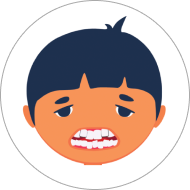Crowded Upper Teeth
Sleep dysfunctions in children can contribute to dental issues such as crowded upper teeth and the subsequent need for orthodontic treatment through several mechanisms. Here’s how these sleep-related problems may affect dental development:
- Oral Breathing Patterns
- Jaw Development
- Tooth Alignment
- Nutritional Factors
- Behavioral and Psychological Factors
- Cognitive and Attention Issues
- Long-Term Consequences
- Intervention and Management
In summary, sleep dysfunctions in children can contribute to crowded upper teeth and the need for orthodontic treatment through mechanisms related to altered oral breathing patterns, abnormal jaw development, improper tooth alignment, and behavioral factors. Early intervention and addressing sleep issues can help mitigate these effects and promote better dental health outcomes.
Sleep dysfunctions in children can contribute to dental issues such as crowded upper teeth and the subsequent need for orthodontic treatment through several mechanisms. Here’s how these sleep-related problems may affect dental development:
1. Oral Breathing Patterns
- Mouth Breathing: Children with sleep dysfunctions, particularly those with obstructive sleep apnea (OSA), may resort to breathing through their mouths during sleep. This can alter the development of the jaw and facial structures, leading to dental crowding and misalignment.
- Altered Tongue Position: Proper tongue posture is essential for the normal development of dental arches. Mouth breathing can lead to a lower tongue position, which may not provide the necessary pressure against the dental arches, contributing to improper growth and crowded teeth.
2. Jaw Development
- Abnormal Jaw Growth: Sleep dysfunctions can affect the growth and development of the maxilla (upper jaw) and mandible (lower jaw). Conditions like OSA may lead to a narrower upper jaw due to improper positioning during sleep, resulting in dental crowding.
- Facial Structure Changes: Chronic mouth breathing and altered sleep positions can lead to changes in facial structure over time. A long, narrow face can contribute to crowded teeth and an improper bite.
3. Tooth Alignment
- Insufficient Space for Eruption: When the jaws do not develop properly due to sleep dysfunctions, there may be insufficient space for teeth to erupt correctly. This can result in overlapping teeth and crowding, necessitating orthodontic treatment.
- Disruption of Eruption Patterns: Sleep issues can impact the timing of tooth eruption. Delayed or altered eruption patterns may lead to misalignment and crowding of teeth.
4. Nutritional Factors
- Diet and Nutritional Deficiencies: Poor sleep can lead to dietary choices that are less conducive to oral health. A diet lacking in essential nutrients can affect bone and tooth development, potentially contributing to crowded teeth.
- Increased Sugary Snack Consumption: Children with sleep issues may consume more sugary snacks late at night, increasing the risk of dental problems and misalignment due to decay or structural changes in the teeth.
5. Behavioral and Psychological Factors
- Bruxism (Teeth Grinding): Sleep dysfunctions can lead to increased stress and anxiety, which may manifest as bruxism (grinding of teeth) during sleep. This can cause misalignment and crowding due to the pressure exerted on the teeth.
- Changes in Oral Habits: Sleep disturbances can lead to changes in oral habits, such as thumb-sucking or prolonged pacifier use, which can negatively affect dental alignment.
6. Cognitive and Attention Issues
- Inattention to Oral Hygiene: Children experiencing sleep dysfunctions may be more fatigued and less attentive to maintaining good oral hygiene. Poor dental care can exacerbate dental issues, contributing to the need for orthodontic treatment.
- Increased Risk of Dental Anxiety: Sleep-related issues can lead to behavioral problems, including anxiety around dental visits, which may delay necessary orthodontic care.
7. Long-Term Consequences
- Progression of Misalignment: If dental crowding is not addressed early, it can worsen over time, leading to more significant orthodontic issues in adolescence or adulthood.
- Increased Treatment Complexity: Sleep dysfunctions can contribute to more complex dental and orthodontic issues, requiring more extensive treatment as children grow.
8. Intervention and Management
- Early Assessment: Identifying sleep dysfunctions early can help in assessing their impact on dental development. Regular dental check-ups can help monitor any changes in tooth alignment or jaw development.
- Collaborative Care: Addressing sleep issues in collaboration with dental professionals can lead to better outcomes for children’s dental health, potentially reducing the need for extensive orthodontic treatment.
In summary, sleep dysfunctions in children can contribute to crowded upper teeth and the need for orthodontic treatment through mechanisms related to altered oral breathing patterns, abnormal jaw development, improper tooth alignment, and behavioral factors. Early intervention and addressing sleep issues can help mitigate these effects and promote better dental health outcomes.

